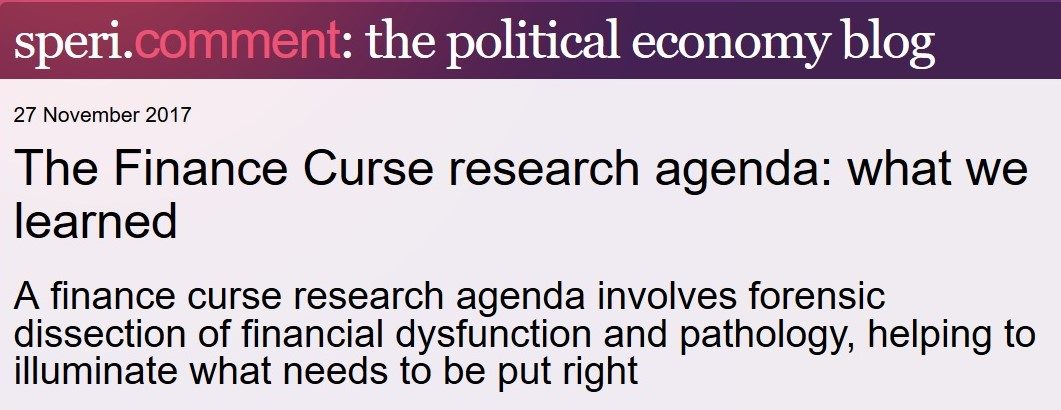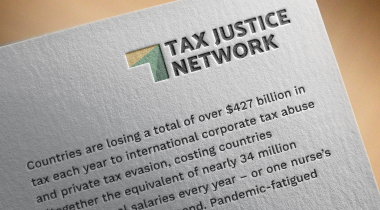
John Christensen ■ The Finance Curse research agenda: what we learned

Earlier this month scholars from seven countries and seven disciplines, representatives from four NGOs, journalists from the Financial Times and Le Monde, and a Bank of England official met in Sheffield to scrutinise and dissect the concept of the Finance Curse. The concept and broad frame of the finance curse, was subjected to a process of empirical and conceptual stress testing over a day and a half. The exercise established where good data and understanding exists, where gaps in existing knowledge lie and where further exploration is required.
The finance curse concept draws parallels with the idea of a resource curse, which in turn identifies the over reliance of some developing countries on natural mineral extraction and the political, social and economic pathologies that result. But there is need for care in over using the resource curse analogy to understand the evolving financial world and some of its dysfunctions. The finance curse has some similarities to the resource curse phenomenon, but it is a distinctive process that is likely to vary by location.
The main similarity between resource curse and finance curse processes is a crowding out effect, with ‘Dutch Disease’ providing one example. In some countries, the UK, pre-Brexit for example, Dutch Disease was evident in an inflated exchange rate, damaging export potential due to the capital inflows associated with hosting a major financial centre. The problem, as Alberto Botta has noted, is that in many developing countries, and in all likelihood the UK, a lower exchange rate does not miraculously reverse poor export performance. More generally, Dutch Disease refers to local price inflation (particularly the exchange rate and property) caused by capital inflows. Any finance curse research agenda has to explore the wider sets of dysfunctional spillovers such price movements and financial flows generate for the social and geographical fabric of host communities. It is precisely these patterns that Rowland Atkinson’s research on neighbourhood life in London has documented. Interestingly, there is evidence to suggest the spillovers may be far more penetrating and far reaching where finance is concerned and ethnographic research has a role to play in uncovering them.
In countries that display finance curse symptoms, other sectors can suffer from diminishing levels of financial and human capital, due to the magnetic effects of an over-sized financial sector. While more needs to be done to establish the veracity of such effects, the existing evidence is sufficient to merit greater policy vigilance. Christiane Kneer has shown that the development of securities markets enhances financial salaries and depletes other skill intensive sectors of skilled labour damaging overall productivity levels. Gerbrand Tholen’s research on the UK’s graduate labour market highlights a more complex pattern of training and matching skill acquisition to employment need. Processes within the financial sector reveal differential rates of pay and the undervaluation of certain skill sets. Remuneration policies in the financial sector and their wider social and economic effects certainly warrant further attention.
From macroeconomics a ‘too much finance thesis’ has emerged, which is one element of the finance curse. This research is well developed in some aspects and less so in others. Our keynote speaker, Gerald Epstein, calculated the costs to the United States economy of its financial sector across three categories: rents and excess profits; misallocation; and the crisis costs of 2008. Gerald openly admits that the number he arrives at, an excess cost of $22.3 trillion between 1990 and 2023, is likely to be a modest underestimation because the costs of the financial crisis may be much greater and the numbers do not involve lost tax revenues from various financial innovations. Ugo Panizza and his colleagues identify a turning point when credit to the private sector reaches around 90 per cent of GDP, past which there is a loss in growth. Their data suggests this is more than just the costs of crisis, but the result of a misallocation effect.
Misallocation, financial sector short-termism and extraction largely remain black boxes however. One finance curse research objective has to be to illuminate these areas. More quantitative work can help, but we also need qualitative work that can illuminate how and why misallocation and extraction processes occur, and with what effects. Misallocation implies having a large liquid financial sector with lots of evolving asset forms sucking capital away from other potential activities. But how that happens and what you can do to prevent it – are in many respects the crucial questions of the finance curse as a research agenda.
This is why the work of Brett Christophers on how market concentrations are constructed in legal form and how that effects rates of profit and rewards is so important. Likewise, the work of Adam Leaver on extraction processes connected to private finance initiatives (PFI) in the UK, and in relation to how derivatives markets operate as social networks helps to illuminate the realities, costs and risks of extractive processes. Daniela Gabor’s work on the constituent processes of shadow money creation and stabilization, gives us a sense of how asymmetrical power functions in financial markets and the costs and problems associated with that, as well as the need for new social contracts between public authorities and market actors.
Crucially, these kinds of processes are not neutral in distributional terms. The search for new markets, when some revenue streams dry up, has resulted in the financialization of some lower end New York rental markets. Desiree Fields’ research on the social costs of these processes in terms of housing conditions for low income groups is part of excavating the wider social relations and costs of ‘financialization’. It helps to establish the micro-foundations and mechanisms of the broader macro-process of how financialization impacts on life chances and living standards in large urban cities in ways that expand inequality and social-stratification, as also explored in the work of Olivier Godechot. The challenge in understanding how financial innovations relate to and feed inequality is to have a sense of both micro and macro processes and how they connect.
The hold financial firms have over the policy and political arena is the area in which there is least consensus. A strong and somewhat crude ‘capture’ thesis has become a target in the international political economy literature, with rich empirical work showing financial lobbies do not get all that they want all of the time. The notion of capture is beset by definitional and semantic problems. Angela Wigger noted that public agencies and authorities at multiple levels are often active players in creating and shaping markets, rather than passive ones bent to the will of private interests. Capture may therefore have the wrong connotation and create public-private divides that are increasingly hard to maintain. Abby Innes’ work suggests capture can be a broader corporate process, rather than distinctly financial.
Ultimately, a too literal fine grained approach to capture can risk descending into arcane academic debates that obscure the bigger broader picture. Narratives and assumptions about finance and its benefits matter. They shape policy and political arenas, as my work with Duncan Wigan has shown. The finance curse encourages a much more sceptical approach to the claim that more financial innovation is always good. Crucially it also facilitates a more forensic dissection of financial dysfunction and pathologies, that can in turn help to illuminate what needs to be put right, and helps us to imagine what a more socially useful financial system might actually look like.
Related articles

The Financial Secrecy Index, a cherished tool for policy research across the globe

New Tax Justice Network podcast website launched!

Como impostos podem promover reparação: the Tax Justice Network Portuguese podcast #54

Convenção na ONU pode conter $480 bi de abusos fiscais #52: the Tax Justice Network Portuguese podcast

As armadilhas das criptomoedas #50: the Tax Justice Network Portuguese podcast

The finance curse and the ‘Panama’ Papers

Monopolies and market power: the Tax Justice Network podcast, the Taxcast

Tax Justice Network Arabic podcast #65: كيف إستحوذ الصندوق السيادي السعودي على مجموعة مستشفيات كليوباترا

Remunicipalización: el poder municipal: January 2023 Spanish language tax justice podcast, Justicia ImPositiva



This blog gives us information about the financial malfunction. The Dutch disease mentioned is a good example of this blog. The financial curse is very worst in everyone’s life. The points given is very useful but it could in simple clear English which will be very useful for us.